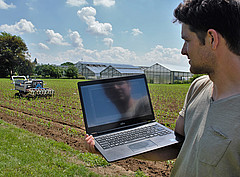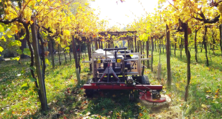BW elite Hohenheim postdoc
Robot Learns to Care for Orchards [27.02.20]

Dr. David Reiser works at the Institute of Agricultural Engineering on the development of autonomous field robots.
The phase between a doctorate and obtaining a professorship is fraught with numerous challenges: In order to support young scientists and enable them to become academically independent more quickly, the Baden-Württemberg Foundation has set up an elite program for postdocs. Each year, up to 15 persons with above-average doctoral achievements are accepted. They receive individual funding of up to 150,000 euros for personnel, material, travel, and investment costs. Special attention is also paid to networking.
Orchard meadows characterize the traditional cultural landscape of Baden-Württemberg. They are not only scenic and contribute to the preservation of traditional fruit varieties, but also play an important role for biodiversity. For example, compared to an extensively managed orchard, an orchard meadow has about 85% more spider species, 50% more ground beetles, 6x more flying insects, and 16x more bee species.
Southwest Germany still has the largest cohesive areas in Europe. But the orchard meadows are acutely threatened. Despite support measures, the cultivation of small-scale areas which combine different fruit trees of different ages, is hardly profitable. At present, therefore, the trees on around 80% of the areas are not pruned at all or only pruned irregularly. However, regular pruning is necessary to keep them durable and healthy.
Robot to learn how to cut branches in orchards

Der Roboter-Prototyp "Phönix" kommt heute schon in Weinbergen zum Einsatz. Bild: David Reiser
This problem challenged the tinkering spirit of Hohenheim agricultural engineer Dr. David Reiser, who has dedicated himself to the development of autonomously acting robots at the Department of Process Engineering in Plant Production.
"Prototypes are becoming increasingly better at dealing with the complex environments in the field or vineyard. However, the use of robots has so far only been implemented in row-based structures that can be more easily reconstructed as 3D models. A lot of innovative development work is needed to be able to use such machines for branch cutting in orchards," explained Reiser.
In a current research project, the Hohenheim postdoc will now take up this challenge. The starting point is an existing caterpillar-shaped robot prototype ("Phoenix") that is to be equipped with a special gripper arm with sensors and actuators so that it can recognize trees as 3D objects and cut back branches up to a height of 7 meters. The robot is to carry out this task first semi-autonomously, i.e. under supervision, and then completely independently.
€ 113,000 grant for outstanding young scientists
Dr. Reiser has now succeeded in raising 113,000 euros from the Baden-Württemberg Foundation's elite program for postdocs. The program was set up to provide support in the challenging phase between obtaining a doctorate and getting a professorship.
After all, young scientists actually face great challenges during this time: Excellent research and outstanding publications are expected as well as numerous teaching tasks. In addition, it is not uncommon for postdocs to be active in science management or academic self-administration. The general conditions are characterized by intense competition for a few positions, high dependence on the professor under which the person works, and, in some cases, limited financial leeway in developing their own research priorities.
"I first heard about the program during my doctorate - and finally took the opportunity last year to apply with the robotics project. I was very happy about being accepted. Without the support of the BW Foundation, I would not be able to realize the project in its current form. At the same time, I consider it a great recognition of my work," said Dr. Reiser.
2-stage application procedure
The number of possible applications per university is limited (Hohenheim: 5 applications per year). Therefore, a university internal pre-selection takes place first. Interested postdocs submit a 1-page outline of the project idea and a qualification concept, which includes a scientific curriculum vitae and future steps for strategic career planning.
The Senate Commission for Research at the University of Hohenheim selects up to 5 draft proposals. After a positive decision, the postdocs then have about 8 weeks to prepare a complete proposal. The Research Funding Department offers support in this regard.
Text: Leonhardmair / Translation: Neudorfer